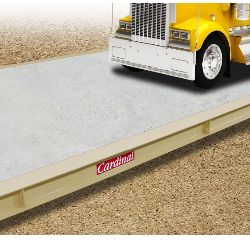Have you ever wondered why do we even need to weigh trucks? Or why do we even need weigh stations on the interstate highway? Weigh stations were created to enforce safety regulations for big trucks that you see on the highway. These truck scales allow each state to check the freight carrier’s compliance with fuel tax laws; to check weight restrictions; to check equipment safety and to check compliance with Hours of Service Regulations. A Truck scale is a large set of scales, usually mounted permanently on a concrete foundation, that is used to weigh entire vehicles and their contents. By weighing the vehicle both empty and when loaded, the load carried by the vehicle can be calculated. Weigh stations are regulated by individual state governments and therefore have vastly different requirements from state to state. They are typically operated by the state’s Department of Transportation (DOT) or Department of Motor Vehicles (DMV) in conjunction with the state highway patrol or state police, thus enabling enforcement of applicable laws. The federal maximum weight is set at 80,000 pounds.
Trucks exceeding the federal weight limit can still operate on the country’s highways with an overweight permit, but such permits are only issued before the scheduled trip and expire at the end of the trip. Overweight permits are only issued for loads that cannot be broken down to smaller shipments that fall below the federal weight limit, and if there is no other alternative to moving the cargo by truck. Permitted oversize trucks are often required to coordinate with the Departments of Transportation and law enforcement agencies of the transited states before the trip begins, as most states require oversize trucks to be escorted. Many states have weigh in motion technology that allow a continuous flow of truck weighing.
Many states also check freight paperwork, vehicle paperwork, and logbooks to ensure that fuel taxes have been paid and that truck drivers are obeying the Hours of Service (a federal requirement). Also, the truck and driver may have to undergo a DOT inspection, as most states perform the bulk of their DOT inspections at their weigh stations. In some cases, if a truck is found to be overweight, the vehicle is ordered to stop until the situation can be fixed by acquiring an overweight permit. In other cases, the driver may receive an overweight ticket and may or may not be required to offload the extra freight. Offloading the extra freight may not be practical for perishable or hazardous loads. Two types of loads may result in overweight trucks: divisible and non-divisible. A divisible load is a load which can be easily divided into smaller parts, such as products that are shipped on pallets, automobiles or grains. A non-divisible load is a load which is unable to be divided into smaller parts, like a piece of equipment or a steel beam. All states provide permits for non-divisible loads though the truck may have restricted routing. Some states allow tolerances for any over weight truck. Some states have specific allowances for types of loads for which they will allow tolerances.

